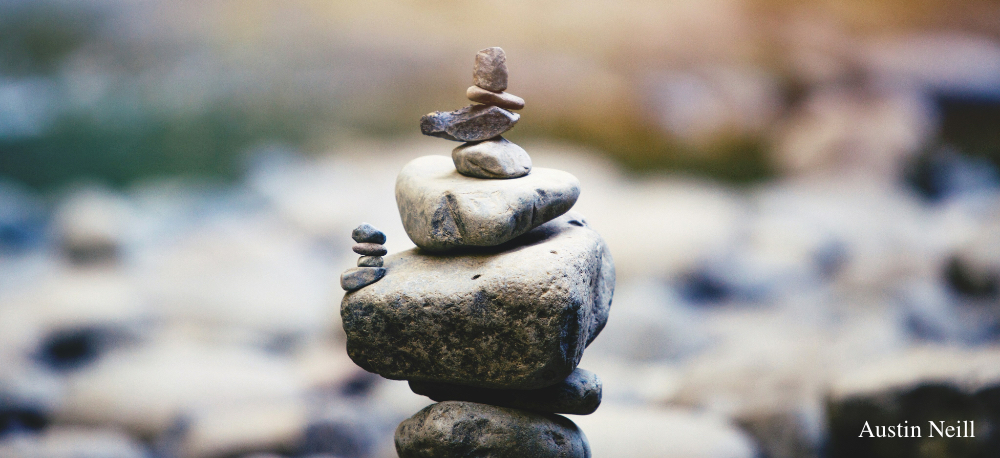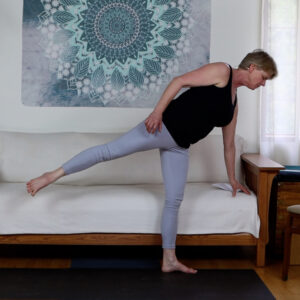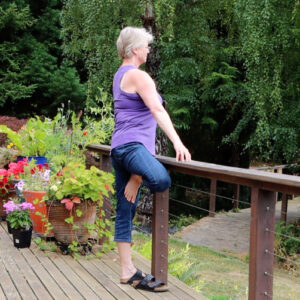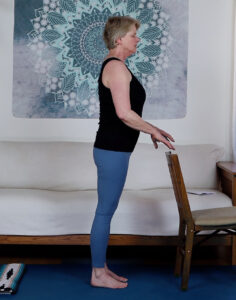
When you balance, whether on two feet, or on your head, you are strengthening muscles essential for the stability of total hip replacement. Balancing challenges your ability to focus, to react to fluctuations in your body, and to maintain your center of gravity. It is a mental practice as much as a physical one.
When you practice balancing you not only …
- improve brain health,
- reduce your chance of falling,
- maintain physical coordination,
- improve your reaction time….
- but you also strengthen key muscles that support your hip joint!
Balancing helps keep the brain healthy. It improves memory. It hones proprioceptive skills. And, it strengthens regions of the brain that are responsible for balance and for orienting us in space. Plus, the focus required when we balance quiets the activity of the mind. This is yoga!!
As we lose our ability to balance, our stability diminishes, and this puts us at risk of falling. Osteoarthritis of the hip usually is accompanied by chronic pain, reduced muscle strength, and reduced ability to perform daily activities. This includes balancing and is why a yoga practice that includes standing poses — and especially balancing poses — helps keep the key muscles responsible for our stability strong and reduces the risk of falling.
Studies show that balancing improves physical coordination and reaction time. On the yoga mat you have a safe and controlled environment where you can practice balancing. Take advantage of this safe place to experiment and hone your balancing abilities. Finding your balance on the mat will translate to better balance out in the world.
When you practice balancing you strengthen key muscles that support your hip joint. In truth, when you balance you strengthen muscles that provide stability throughout the body, including muscles that support the hip joint. Consider a pose like Half Moon Pose / Ardha Chandrasana. There is strong outward rotation in the standing leg which strengthens the external rotators. There is hip flexion in the standing leg which strengthens hip flexors and the hamstring muscles. All these muscles play a roll in supporting the hip joint.

Take your balance off the mat! Balancing is something that you can practice almost anywhere like when in line at the grocery store, while doing dishes at the kitchen sink, or when standing on your deck taking in the view.

Consider how standing on two feet in Mountain Pose is a form of balancing. It may seem simple but all you need to do is introduce some small variations and you will begin to challenge your balance:
- Try standing in Mountain Pose with your eyes closed. Focus your attention on how your weight shifts under your feet and how your body is constantly finding its center of gravity.
- Try lifting your heels to shift your weight slowly onto the balls of your feet. Can you balance on the balls of your feet for a few seconds?
- Try closing your eyes AND balancing on the balls of your feet. Notice how much we rely on our eyes for our sense of balance.

As you move toward more challenging balancing poses following THR, start small, experiment with the easier variations, and watch how your body and your mind responds. And don’t be shy about using props. If you are unsure of your balance, be sure to have a countertop, chair, tree, or grocery cart nearby to hold on to.
“Balance is not something you find, it is something you create” – Jana Kingsford
Here’s to Healthy and Happy Hips!
Key Takeaways
- Balancing is a full-body practice that strengthens key muscles supporting the hip joint, improving long-term stability after total hip replacement (THR).
- It sharpens mental focus and brain health, improving memory, coordination, and proprioception.
A consistent balance practice helps reduce the risk of falls, which is especially important for those recovering from THR or managing osteoarthritis. - Simple poses like Mountain Pose or more advanced ones like Half Moon Pose strengthen hip flexors, external rotators, and hamstrings — all crucial for hip joint stability.
- Balancing can be practiced off the mat in everyday situations — from brushing your teeth to standing in line at the grocery store — reinforcing stability and building confidence.
- Using props or support (like a chair or countertop) while practicing balance allows for safe experimentation and progress in your recovery.
Frequently Asked Questions (FAQs)
1: Is it safe to practice balancing yoga poses after a total hip replacement? Yes, balancing poses are safe when introduced gradually and mindfully. Always start with basic variations and use props for support. Consult with your surgeon or physical therapist before beginning any new movement practice post-surgery.
2: What are the best yoga poses for improving balance after hip replacement? Mountain Pose (Tadasana), Tree Pose (Vrksasana), and Half Moon Pose (Ardha Chandrasana) are excellent for strengthening the muscles that support the hip joint and improving balance.
3: Why is balance so important after hip replacement surgery? Balance reduces your risk of falling, enhances joint stability, and strengthens the muscles surrounding your new hip. It also improves coordination, reaction time, and confidence during movement.
4: Can balancing help with brain health too? Yes! Balancing improves proprioception, memory, and strengthens the areas of the brain responsible for spatial awareness. It also calms the mind through focused concentration.
5: How can I practice balance safely at home? Start with simple poses like standing with your eyes closed or lifting your heels. Practice near a wall, chair, or counter for support. Even everyday tasks — like standing while brushing your teeth — are great opportunities to practice.
6: What if I feel wobbly or unsteady? That’s completely normal! Use props, take your time, and focus on gradual progress. Even just shifting your weight mindfully from one foot to the other is a powerful balancing practice.
7: How often should I practice balancing? Just a few minutes daily can lead to noticeable improvement. Incorporating balance into your routine regularly will yield the best long-term benefits.
Member Videos: Tree Pose / Vrksasana, Half Moon Pose / Ardha Chandrasana, Feet, Legs, Pelvis Position in Open-hip Poses,
Non-Member Preview: Yoga Basics, Standing Poses
Free video: Yoga while healing from Total Hip Replacement Surgery: A safe post-op asana practice
Become a member of Yoga for Hip Replacement here
Articles and Studies:
Blog: “Strength – THR’s Best Friend”
Blog: “Go Slow – Build New Neural Pathways”
“Muscle strength, pain and disability in patients with osteoarthritis”
“Balance and gait in total hip replacement: a pilot study”
“Improvements in balance after total hip replacement”
